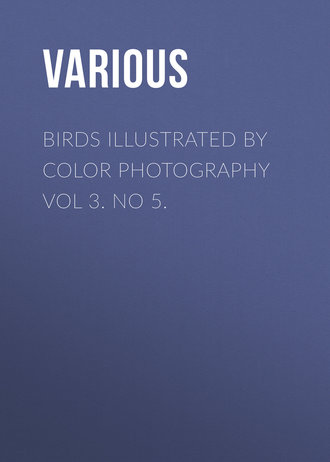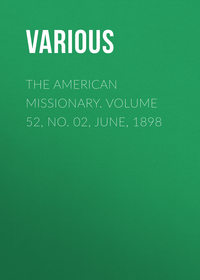 полная версия
полная версияBirds Illustrated by Color Photography Vol 3. No 5.

Various
Birds Illustrated by Color Photography Vol 3. No 5
COLOR IN MUSIC
"No ladder needs the bird, but skiesTo situate its wings,Nor any leader's grim batonArraigns it as it sings.The implements of bliss are few —As Jesus says of Him,'Come unto me,' the moietyThat wafts the cherubim."– Emily Dickinson.OH, Music! voice inspired of all our joys and sorrows, of all our hopes and disappointments, to thee we turn for life, for strength and peace. The choristers of Nature – the birds – are our teachers. How free, how vital, how unconstrained! The bird drops into song and delicious tones as easily as he drops from the bough through the air to the twig or ground. To learn of the bird has been found to be a truthful means whereby children's attention and interest may be held long enough to absorb the sense of intervals in pitch, notation on the staff, and rythms.
In teaching a child, it is obvious that the desire to learn must be kept widely awake, and heretofore black notes on five lines and four spaces, with heiroglyphics at the beginning to denote clef, and figures to indicate the rhythm of the notes, have never interested children. But now, color and the bird with its egg for a note, telegraph wires for the staff, and swinging the pulsing rhythm instead of beating the time, has charmed children into accomplishment of sight singing and sweet purity of tone. Formerly, and by the old method, this was a long and laborious task, barely tolerated by the musical child and disliked by the little soul unawakened thereby to its own silent music.
It may be questioned, what is the new method, and what its value? The method is this: In recognizing tone, the finer and more sensitive musician has realized that certain intervals of scale suggested to their minds or reminded them of certain colors. Thus the Doh, the opening and closing tone of the scale, the foundation and cap stone, suggested Red, which is the strong, firm color of colors, and on the ethical side suggested Love, which is the beginning and end, the Alpha and Omega of Life. This firmness and strength is easy to recognize in the tune "America," where the tonic Doh is so insistent, and colors the whole melody. "The Star-Spangled Banner" and "Hail Columbia" are other strong examples.
The Dominant or fifth tone in the scale is clear and pure, which the blue of heaven represents, and so also the quality of aspiration or exaltation is sounded. This is joyously clear in the Palestrina "Victory," set to the Easter hymn, "The strife is o'er the battle done."
The Mediant or third of the scale is peaceful and calm, and the color Yellow is suggested, with its vital, radiating, sunshiny warmth and comfort. The "O, rest in the Lord" from "Elijah" exemplifies this quality of restful and peaceful assurance. Of the tones of the Dominant chord besides the Soh which we have considered, the Ti or seventh interval is full of irresolution and unrest, crying for completion in the strong and resolute Doh. This unrest and yearning suggest the mixed color Magenta. The quality is expressed in bits of an old English song entitled "Too Late." The insistency of the seventh is felt in the strong measures with the words, "oh let us in, oh, let us in."
The Ray or second of the scale which completes the Dominant chord is rousing and expectant – quite in contrast to the eagerness and dispair of the seventh. This second is represented by orange, the mixture of red and yellow between which it stands being equally related to both, with the expectancy born of trust and rest which the Mediant expresses, and the rousing hopefulness which is the outcome of the firm strength and conviction of the Doh. As a musical example take Pleyel's hymn set to the words: "Children of the Heavenly King." In the remaining tones of the sub-dominant chord Fah and Lah, we find Fah the fourth has a distinctively leaning tendency, a solemnity which calls forth the direct opposite of the seventh or Ti which yearns upward and cannot be otherwise satisfied, while Fah is a downward leaning, a protective and even-solemnly grand, dependent tone. We hear this in the dead march in "Saul," and the almost stern reproach in the two measures of "Too late, too late, ye cannot enter now." Fah's tonal qualities suggest the protective green.
Lah, or the sixth tone is expresive of tender sympathy, and unlike Fah, is a variable tone which may turn upward or downward for rest. It is found prominently in Minor music and is represented by the half mourning color of lavender or violet. "By the sad sea-waves" is a good illustration of this gentle wail.
While these emotional effects are certainly true, it may be well to remind the reader that when modulation comes in, the character of the tones is necessarily changed; just as the appearance and impression of an individual will be modified and altered by change of surroundings. Consequently these effects are strong only in the pure unmodulated key.
In awakening the musical sensibility of the child, we are rescuing it from probable loss of appreciation for the noble, and true, and fine. This loss is shown by such as are pleased with the trash of the "popular" tunes of a day – tunes which express nothing worthy of the great gift of expression. Music is life in all its moods and tenses, but we should be sensitive only to that which is the expression of the best and most helpful.
Through the many percepts of sight of the birds which represent the intervals of the scale, of touch in pasting the little colored discs on the staff, of ear in singing the tones of the Doh bird, the Me bird, the Soh bird, etc., the child finds the symbols and mechanics of musical notation entrancing instead of tedious.
In teaching the rythms and value of notes the imagination is called upon in marking off rooms instead of measures, and putting one or more bird eggs into them, naming them with the time names and swinging the rythm with a snap-tape measure.
Agnes Stewart.In charge of classes in Color Music and assistant teacher of Voice in The Mrs. John Vance Cheney School, Steinway Hall, Chicago.
CONTENTMENT
ONCE on a time an old red henWent strutting around with pompous clucks,For she had little babies ten,A part of which were tiny ducks;"'Tis very rare that hens," said she,"Have baby ducks, as well as chicks;But I possess, as you can see,Of chickens four and ducklings six!"A season later, this old henAppeared, still cackling of her luck,For though she boasted babies ten,Not one among them was a duck!"'Tis well," she murmured, brooding o'erThe little chicks of fleecy down,"My babies now will stay ashore,And, consequently, cannot drown!"The following spring the old red henClucked just as proudly as of yore;But lo! her babies were ducklings ten,Instead of chickens, as before!"'Tis better," said the old red hen,As she surveyed her waddling brood,"A little water, now and then,Will surely do my darlings good!"But, oh! alas, how very sad!When gentle spring rolled round again,The eggs eventuated bad,And childless was the old red hen!Yet, patiently she bore her woe,And still she wore a cheerful air,And said: "'Tis best these things are so,For babies are a dreadful care!"I half suspect that many men,And many, many women too,Could learn a lesson from the hen,With foliage of vermilion hue.She ne'er presumed to take offenceAt any fate that might befall,But meekly bowed to Providence. —She was contented – that was all!– Eugene Field.THE FASCINATION OF BIRD STUDY
WHEN one knows six birds by sight or sound, it has been said, he is lost. After that he cannot rest until he knows fifty, or a hundred, or two hundred – in his back-door yard, or down in the orchard, or across the farm. It is not easy to explain wherein lies the fascination of "naming the birds without a gun." The humility of the scoffer, caught unawares, and taught his first six before he knows it, is something pathetic and instructive. Few mortals are proof against the charm – when once the first half-dozen are conquered. The first three come easy. Most of us know the Crow – and the Robin – and the Bluebird – and – and – the Sparrow – until we discover that there are more than a dozen varieties of Sparrow, and perceive that this common brown bird, hopping so cheerily in and out of the bushes, may be a Song Sparrow or a Chipping Sparrow or a White-Throated or White-Crowned or any one of the dozen – or even the Cocky English Sparrow, despised by ornithologist and tyro alike. When to the Crow and Robin and Bluebird one has added the Blackbird – both the Keel-tailed and the Redwing – and the Meadow Lark or the Highhole, the charm begins to work. Armed with opera-glass and bird book, the victim casts convention to the winds. He stands in the full glare of the public highway, his glass focused on an invisible spot, an object of ridicule to men and dogs. He crawls on his hands and knees through underbrush, under barbed fences and over stone walls. He sits by the hour waiting for a Vireo to come down from the topmost branch within range of his glass. He forgets luncheon and engagements. And what does he bring home? Certainly not the river and sky, and seldom even a feather.
Books on birds, continues the Boston Evening Transcript, like good wine, need no bush at this season of the year; the Golden-winged Woodpecker drums announcement on every limb; the Redwing Blackbird gurgles and chuckles and calls across the swamp; and the Lesser Sparrows and Bluebirds and Robins wake the morning to the weaving of new song. The hand reaches out for the familiar bird-book; that last note was a strange one. It is a new bird – or merely one forgotten? The delight begins all over with the first Bluebird's call, "a mere wandering voice in the air."
"The Department of Agriculture," Miss Merriam tells us, in her new book, "Birds of Village and Field," "realizing the losses that often result from the ignorant sacrifice of useful birds, constituted the Division of Ornithology, now a part of the Biological Survey, a court of appeal where accusations against the birds could be received and investigated. The method used by the division is the final one – the examination of stomach contents to prove the actual food of the birds. After the examination of about eighty birds, the only one actually condemned to death is the English Sparrow. Of all the accused Hawks, only three have been found guilty of the charges made against them – the Goshawk, Cooper's, and the Sharp-Shinned – while the rest are numbered among the best friends of the fruit-grower and farmer."
THE OSTRICH
SOUTH AMERICAN Rhea is the name by which this immense bird is known to science. It is a native of South America, and is especially numerous along the river Plata. Usually seen in pairs, it sometimes associates in flocks of twenty or thirty, and even more have been seen together. Like all the members of the family, it is a swift-footed and wary bird, but possesses so little presence of mind that it becomes confused when threatened with danger, runs aimlessly first in one direction and then in another, thus giving time for the hunter to come up and shoot it, or bring it to the ground with his bolas – a terrible weapon, consisting of a cord with a heavy ball at each end, which is flung at the bird, and winds around its neck and legs so as to entangle it.
For our knowledge of the Rhea and its habits, we are chiefly indebted to Mr. Darwin, and we shall use his language in this account of the bird. He says it is found also in Paraguay, but is not common. The birds generally prefer running against the wind, yet, at the instant, they expand their wings and, like a vessel, make all sail. "On one fine hot day I saw several Ostriches enter a bed of tall rocks, where they squatted concealed till nearly approached."
It is not generally known that Ostriches readily take to the water. Mr. King says that at Patagonia and at Pont Valdez he saw these birds swimming several times from island to island. They ran into the water both when driven down to a point, and likewise of their own accord, when not frightened.
Natives readily distinguish, even at a distance, the male bird from the female. The former is larger and darker colored, and has a larger head. It emits a singular deep-toned hissing note. Darwin, when he first heard it, thought it was made by some wild beast. It is such a sound that one cannot tell whence it comes, nor from how far distant.
"When we were at Bahia Blanca, in the months of September and October, the eggs of the Rhea were found in extraordinary numbers all over the country. They either lie scattered singly, in which case they are never hatched, or they are collected together into a hollow excavation which forms the nest. Out of the four nests which I saw, three contained twenty-two eggs each, and the fourth twenty-seven. The Gauchos unanimously affirm, and there is no reason to doubt their statement, that the male bird alone hatches the eggs, and that he for some time afterward, accompanies the young. The cock while in the nest lies very close; I have myself almost ridden over one. It is asserted that at such times they are occasionally fierce, and even dangerous, and that they have been known to attack a man on horseback, trying to kick and leap on him."
The skylight in the roof of the apartment in which two Ostriches were kept in the Garden of Plants, Paris, having been broken, the glaziers were sent to repair it, and in the course of their work let fall a piece of glass. Not long after this the female Ostrich was taken ill, and died after an hour or two in great agony. The body was opened, and the throat and stomach were, found to have been dreadfully cut by the sharp corners of the glass which she had swallowed. From the moment his companion died the male bird had no rest; he appeared to be continually searching for something, and daily wasted away. He was removed from the spot, in the hope that he would forget his grief; he was even allowed more liberty, but in vain, and at length he mourned himself to death.
THE SOUTH AMERICAN RHEA
I need'nt tell you I'm an Ostrich, for my picture speaks for itself. I'm a native of South America, but members of my family have been caught and taken to the United States, so you have seen some of them, probably, in a "Zoo."
We are swift-footed and wary birds, but unfortunately have no presence of mind, so that when danger threatens us we become confused, run this way and that way, till the hunter comes up and with gun or "bolas" brings us to the ground.
If your legs and neck were as long as mine, and an Indian should fling around you a cord with a ball at each end and get your legs all tangled up, wouldn't you tumble to the ground, too? Of course you would. That is the way they catch us with a "bolas."
I think we ought to be called "ship of the desert" as well as the camel, for when the wind blows, we expand our great wings, and running against it, like a vessel under full sail, go skimming along, happy as a bird, in truth.
You can never see us do that unless you come to South America. In captivity we act differently, you know. Maybe you have seen us, when in an inclosure, holding our wings from our bodies and running up and down as though we were being chased, appearing greatly alarmed. Well, that is all fun. We have to do something to while the time away. Then, too, that is as near as we can come to "sailing" as we did when wild and free.
You have heard so much about the mother-bird sitting on the nest, that I am sure you will be interested in seeing a father who broods the eggs and hatches out the little ones. I have five wives. They all lay their eggs in one and the same nest, which is a hollow pit scraped out by their feet, the earth heaped up around to form a sort of wall. They lay the eggs, I have said, sometimes thirty in a nest, and I – well, I do the rest.
We are dangerous fellows if disturbed when brooding; have been known to attack a man on horseback, trying to kick and leap on him. Our kick is no love-tap, let me tell you, but being so powerful we can easily kill a man.
When startled, or angry, we utter a kind of grunt as a warning; if it is not heeded, we then hiss sharply, draw back our head, and get ready to strike.
THE BAY-BREASTED WARBLER
ABOUT sixty species of Warblers are known to ornithologists, no one of which can be considered a great singer, but their several twitterings have a small family resemblance. The Bay-breasted, which is also popularly called Autumnal Warbler, breeds from northern New England and northern Michigan northward, its nest being found in low, swampy woods, where there is a mixture of evergreens, oak, birch, elm and other trees. It is compact, cup-shaped, and usually placed in coniferous trees from five to fifteen or even twenty feet above the ground. Fine shreds of bark, small twigs, fibrous roots, and pine hair are used in its construction. Four eggs are laid, which are white, with a bluish tinge, finely speckled on or round the larger end with reddish-brown.
Comparatively little is known of the habits of this species. It passes in spring and fall, on its way to the north, being sometimes abundant at both seasons, but does not tarry long. In general habits, at all times, it closely resembles other species of the genus. In Oxford County, Maine, says Mr. Maynard, these birds are found in all the wooded sections of that region, where they frequent the tops of tall trees. The species seems to be confined during the building season to the region just north of the White Mountains range.
Ridgway says: "Tanagers are splendid; Humming-birds are refulgent; other kinds are brilliant, gaudy or magnificent, but Warblers alone are pretty in the proper and full sense of that term. When the apple trees bloom, the Warblers revel among the flowers, vieing in activity and in number with the bees; now probing the recesses of a blossom for an insect which has effected lodgment there, then darting to another, where, poised daintily upon a slender twig, or suspended from it, he explores hastily but carefully for another morsel. Every movement is the personification of nervous activity, as if the time for their journey was short; and, indeed, such appears to be the case, for two or three days at most suffice some species in a single locality; a day spent in gleaning through the woods and orchards of one neighborhood, with occasional brief siestas among the leafy bowers, then the following night in continuous flight toward its northern destination, is probably the history of every individual of the moving throng."
"Have you walked beneath the blossoms in the spring?In the spring?Beneath the apple blossoms in the spring?When the pink cascades are falling,And the silver brooklets bawling,And the Warbler bird soft calling,In the spring?"BIRD SUPERSTITIONS AND WINGED PORTENTS
THE superstitions of the peasant folk of any country are not only interesting with thought, feeling, and belief, says an intelligent writer, but through them much of the inner history of a people can often be traced. Ireland is peculiarly rich in these forgivable vagaries about birds. They often seem of a very savage and grewsome character, but as we come to know that however grim-visaged the face of one confiding the weird assertion of uncanny belief, that secretly the masses of the peasantry scout and flout them all, save those of a tender and winsome character, we become reconciled to it. Thus the quaint and weird things which might seem unaccountable and often repulsive to us, have become, in lieu of book lore, a folk and fireside lore, out of which endless entertainment is secured; and underneath much of this there is a deep and earnest tenderness, such as all hearts know, for many things without apparent reason, that grow into life and ancestry, oft repeated homeside tale, beloved custom and that mysterious hallowing which comes upon changeless places and objects to men.
Here are a few bird superstitions: If an Osprey be shot along any coast, all the herring and mackerel will immediately disappear. If the Hen-harrier, which only hunts by twilight, is missed from its accustomed raptorial haunt, some evil spirit is said to be hovering about the locality. When Water-ousels appear in the spring time in unusual numbers in any unfrequented locality, it is a sign of abundance of fresh-water fish, but also a token of the approach of malignant disease. On the west coast in the early spring the poor fisherman watches early and late for the Gannet. He calls it the Solan, or Swift-flying Goose. If it does not come his heart sinks, for there will be no luck at fishing; but if great numbers wheel about the headlands of the coast, plenty will smile in his cabin home that year. Great numbers of Jay or Missel Thrushes feeding upon the berries of the hawthorn betoken the approach of a very cold winter, and their Grackle-like calls bring fear to the heart if the meal be low and the peat be scant in the little tenants cabin. When the nest of the Thrush or Mavis is built unusually high in the thorn-bush, this betokens a great calamity to a neighborhood, for some distressing disturbance is under way among the fairies, who in happy or friendly mood always see to it that these nests are built near their haunts in the grasses, that they may more readily enjoy the music of the thrush's songs. The crops of sweet singing Blackbirds are supposed to hold the souls of those in purgatory until the judgment day; and whenever the Blackbird's notes are particularly shrill, these parched and burning souls are imploring for rain, which never fails of coming in response to the bird cries for their relief. The Wicklow mountains are notably the haunts of the Ring-Ousel or Mountain Stars. Whenever, after singing his fine deep song, he hesitates for a time, and then is heard to utter a loud, shrill and prolonged whistle, that night every human that has heard it will remain behind barred doors; for that is a true fairy call, and the "wea folk of Wicklow" are sure to congregate in the mooonlit mountain hollows and "dance rings round their swate selves" until dawn. Of course none of these dire calamities ever occur, but the simple-minded folk continue to have faith in them, and the innocent birds remain the supposed precursors of the, to them, mysterious misinterpreted operations of nature.
THE BLACK-NECKED STILT
STILT would be a peculiarly appropriate name for this bird, with its excessively long legs, were it less graceful and dignified in its walk, moving on land with easy and measured tread, not in a "tremulous manner," says Col. Goss, as stated by some writers.
The Stilt is an inhabitant of temperate North America, from New Brunswick, Maine, Minnesota and Oregon southward; south in winter to Peru, Brazil, and West Indies. It is rare in the middle and western provinces, except Florida, also along the Pacific coast; breeding in suitable localities and in abundance in western Texas, southern Colorado, Utah, eastern Colorado, and southern Oregon. Extensive as is the range of the Stilt, we wonder how many of our readers have ever had the pleasure of seeing even a picture of one. The specimen depicted in Birds is regarded by experts as about as nearly perfect as art can produce. It will be observed that the eyes are alive in expression, as, indeed, are those of all our specimens that have appeared in recent numbers.
This slender wader inhabits the shores of bays, ponds, and swales where scantily covered with short grasses. It swims buoyantly and gracefully, and on land runs swiftly, with partially raised wings, readily tacking or stopping in its chase after insect life. Its flight, says Goss, is not very swift, but strong and steady, with sweeping strokes, legs fully extended and head partially drawn back, after the manner of the Avocet, (see Birds, Vol. II, p. 15), and like the latter, will often meet one a long distance from its nest, scolding and threatening. At such times its legs are as fully extended as its legs, the latter often dangling as it retreats.
The food of the Black-necked Stilt consists of insects, minute shell fish and larvae, and various small forms of life. The birds are social, usually living and breeding in small flocks.
The nests of these birds – when placed on dry, sandy land – are slight depressions worked out to fit the body; on wet lands they are upon bunches or masses of vegetation. Eggs three or four, buff to brownish-olive, irregularly but rather thickly splashed and spotted with blackish brown.











